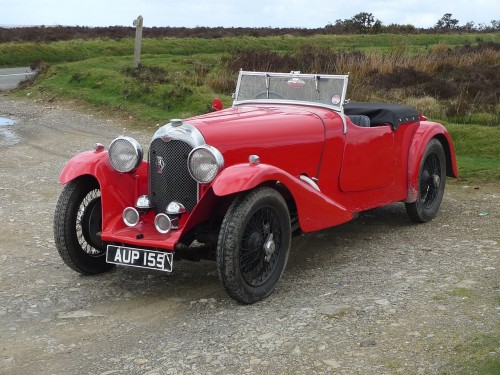
Click Here for Full Screen Image - Click Here to Download Image
 |  |  |  |  | |||||
 |  |  |  |  | |||||
 |  |  |
| Lot number | 126 |
|---|---|
| Hammer value | £30,000 |
| Description | Marendaz 15/90 |
| Registration | AUP 155 |
| Year | 1936 |
| Colour | Red |
| Engine size | 2,443 cc |
| Chassis No. | 7417 |
| Engine No. | 38447 |
The enigmatic South African born Donald Marendaz was a man brimming with energy.
Employed by Siddeley-Deasy as an apprentice, he left during 1916 to join the Royal Flying Corps (RFC). After just 20 hours of training he found himself in full combat, proving brave and fearless, flying in all conditions on reconnaissance missions for the Cavalry. Invalided home in 1918 he had a brief fling with the fledgling Alvis concern before setting up his own car company, Marseel, along with Mr Seelhaft, another ex-Siddeley-Deasy apprentice.
Using proprietary engines and transmissions and a local coachbuilder, some 1,200 Marseels, (or Marseals as they became known when Seelhaft departed the business) were delivered before the doors closed in 1925. The price and quality of the mass-produced Austins and Morris rivals were to put many such small manufacturers out of business by the mid ‘20s.
Moving to London, he formed the Marendaz Company, entering the more lucrative sports car market. Sharing premises with Bugatti’s London outlet in Brixton, he introduced the Anzani engined Marendaz Special 13/70. Coachwork was very stylish, the car sporting a radiator design shamelessly copied from Bentley. Those who dared suggest this were immediately threatened with legal action, as was anyone who ever queried his rather extreme claims as to the performance of his cars. The winged badge on the radiator also bore a remarkable similarity to that of the RFC!
Marendaz developed his own engine block, made his own gearboxes and back axles, incorporating a number of off-the-shelf components within which led to many of his models being incorrectly described as being fitted with other makers' engines. The 2,467cc 17/97 followed, along with the 1,991cc 15/90 which did in fact use a 6-cylinder Coventry-Climax sourced engine and was good for 84mph. The coachwork sprouted wild external chrome exhausts, whilst under the bonnet some models had faux rocker-box covers to hint at the performance that might (or might not) lie within.
Owners of the remaining 25 or so Marendaz cars believe that the bhp figures quoted were somewhat optimistic, a statement which, if made in period, would no doubt have incurred the wrath of Capt Marendaz and a stern letter from his solicitor. In all, somewhere between 80 and 120 Marendaz models are thought to have been made, the highest chassis number being somewhere in the 200s, but in true Marendaz tradition, no even numbers ever appear to have been issued!
In period Aileen Moss (Sir Stirling’s mother) was a keen exponent of the marque in competition, the family at one point investing in the company. Marendaz finally stopped manufacture in 1936 and joined a City firm until the outbreak of World War Two. Even then his notoriety continued as he became a friend and supporter of Oswald Moseley. In the end he got fed up and returned to his native South Africa where he made stationary diesel engines until 1971 when he once again returned to England. He died in 1988 at 91 years of age.
The vendor of this 15/90 was tipped off about its whereabouts by friend and Marendaz expert, John Shaw. Dragged out of the proverbial ‘lock-up’ in Southend-on-Sea in 1973, it was reasonably complete apart from its engine which was long gone. £425 changed hands and a protracted restoration embarked upon. A photograph on file confirms that it was sold new to the Durham Constabulary as their high speed pursuit vehicle, although it appears to have spent more time as the personal transport of the Chief Constable! Nothing is currently known of its history in the intervening years.
Upon investigation, some of the woodwork needed replacement, along with a few areas of panel work at the back of the car. The rest was basically sound and remains remarkably original, retaining the original wings, bonnet and scuttle. The rest of the chassis was restored, including the Marendaz rear axle and gearbox which needed a complete new set of gears. The gearbox has the interesting feature of reverse being ‘beyond’ first, making use of the ingenious catch stopping its accidental engagement very important, especially at traffic lights!
Unable to find a replacement six-cylinder Coventry-Climax unit, the vendor, a Riley exponent, decided to fit a pre-war Big-Four engine. He managed to find one from a car which had been bombed out at the start of the War. Dating from 1937 or 1938, the car had done very little work before it was laid-up and then literally had its ‘doors blown off’. Stripped and rebuilt with new white metal (the original had gone brittle over time) the engine was installed along with a later RMB twin-carburettor manifold. It provides terrific performance and is thought to develop in the region of 100bhp.
Along with a cleverly concealed hood, the car comes complete with side screens and a tonneau cover. In addition, the vendor has agreed to throw in his well-thumbed copy of Mayfair Magazine, which along with many other interesting and informed articles includes Bill Boddy’s feature on the Marendaz.
On the button and ready to go, we were treated to a lengthy run across Exmoor to take the pictures for the catalogue, the car flattening out all the hills encountered with contemptuous ease and running very sweetly indeed. Dubbed the ‘poor man's Bentley’ in period, the same could be said today, this Marendaz offering similar performance and looks for a mere fraction of the price of a Bentley from the same period. All that and a copy of Mayfair too – what more could a gentleman ask for?